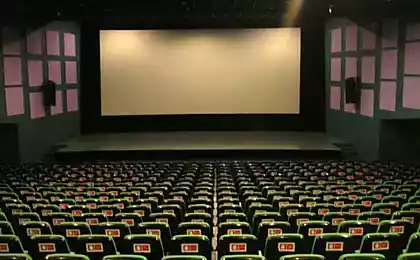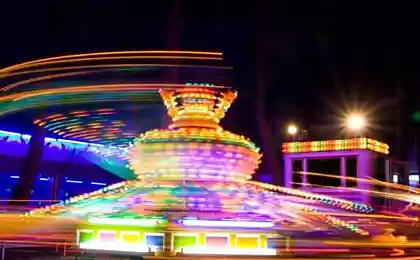1094
Cinema Park IMAX
In mid-February, and I was invited to tanattor'a shooting in the newly opened "Cinema Park". The results of this campaign was a small report from the technical rooms, where ordinary people are denied access.
47 photos via
10th room was free all day, so you can not rush, and do some staged shots.

2.

3.
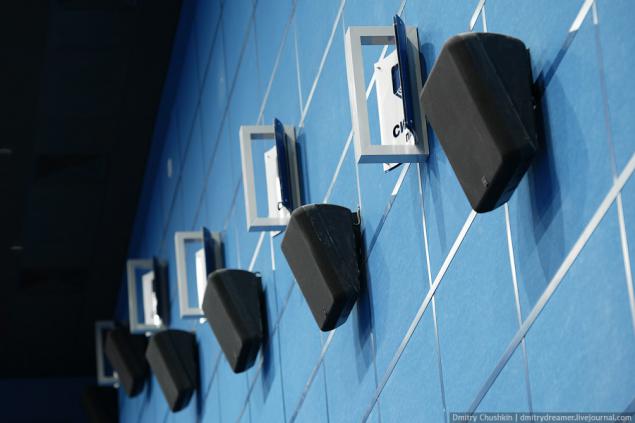
4. Taking a walk around the room, I made for myself a small opening. It turns out the screen surface is not continuous, and perforated over the entire area.

5. The answer was found pretty quickly. As soon as we went into the room behind the screen, we were greeted by the speakers are rather big subwoofer and center channel. To the sound from them reaches the viewer in its entirety and have made millions of holes in the screen.
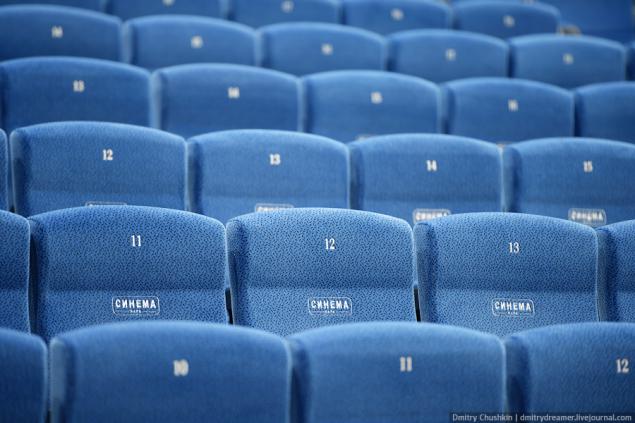
6. Now go behind the scenes of leisurely. Classical room projectionist for each of the halls here. The unified system of corridors focused projectors working in all 10 rooms. Thanks to this designing the room, two people is enough to control all the settings.
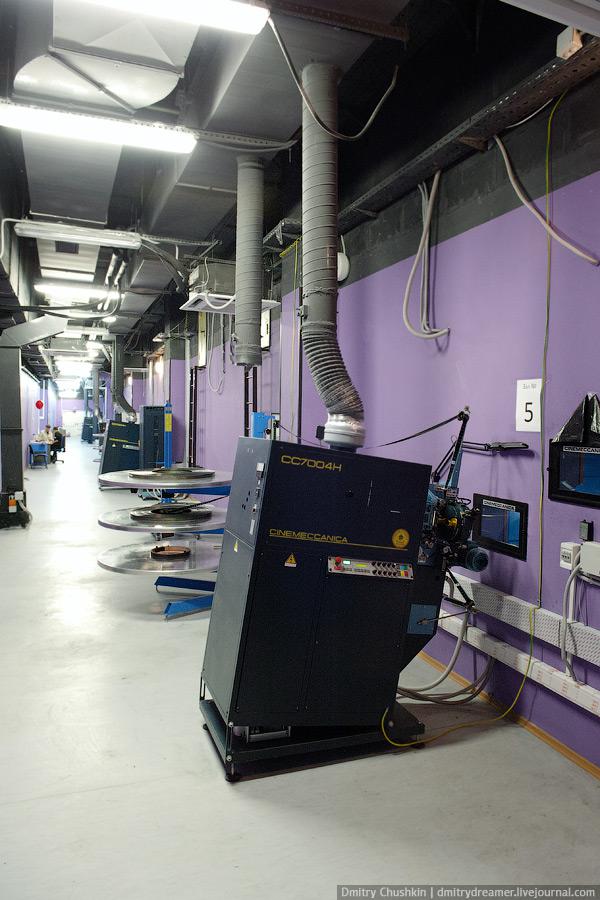
In the long corridors between them peacefully coexist digital and film projectors. We begin our story with the film process.
7. Films on 35 mm film comes on a standard round bobbins. One film fits an average of six rolls.
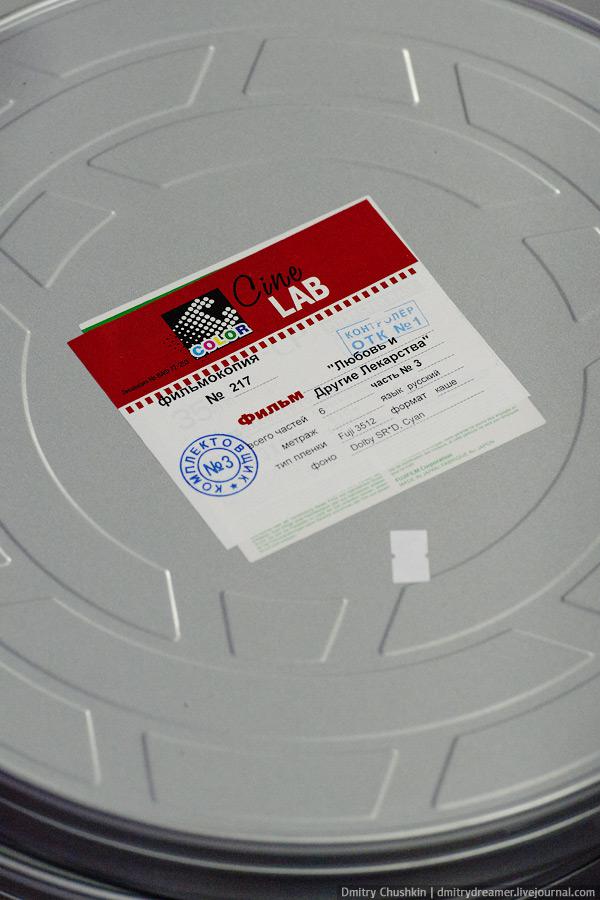
8. At the beginning and end of each film there is leader tape - a blank portion of the film. Its purpose will be discussed below.
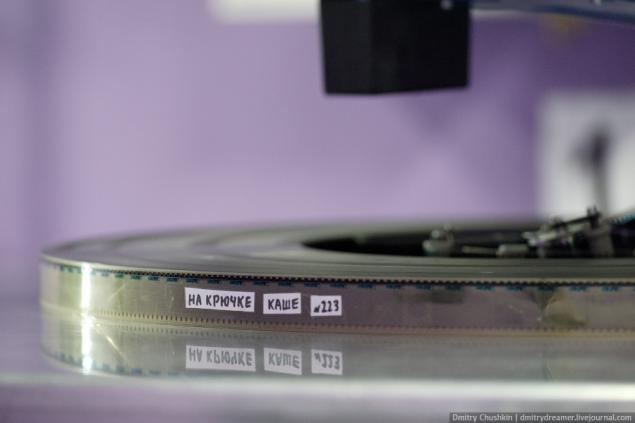
As the projectionist is controlled by this good? To do this, let's look at the pages of history. Previously, one room worked two projectors. This made it possible to show films without breaks between the parts. As soon as the part of one projector in sync with the projector includes another new part of the film. And so, on average, every 15-20 minutes. To projectionist just launched a new part of the film, at the end of each part is a black and white dots, squares (usually in the upper-right corner of the frame), which fueled the initial leader tape in the machine. When you see the final points of the leader tape projectionist manually start the engine and then the second lamp unit. By the way these points, and sometimes bezformennye squares and triangles can be seen in all the old movies. However manual synchronization was very ancient times. Less modern equipment already had automatic synchronization parts.
But modern technology does not cease to make life easier for the projectionist. Now it is not necessary every 15 minutes to put a new reel of film. Yes, and the projector is sufficient to have only one. That greatly simplifies maintenance.
9. Before showing the film, all the reels of film is wound into a coherent whole. Parts of the glue on the transparent leader tape. As I said, the mechanics, the length of the film in such a mega-coil about 5 km. The reader has the opportunity to find, so whether it is.
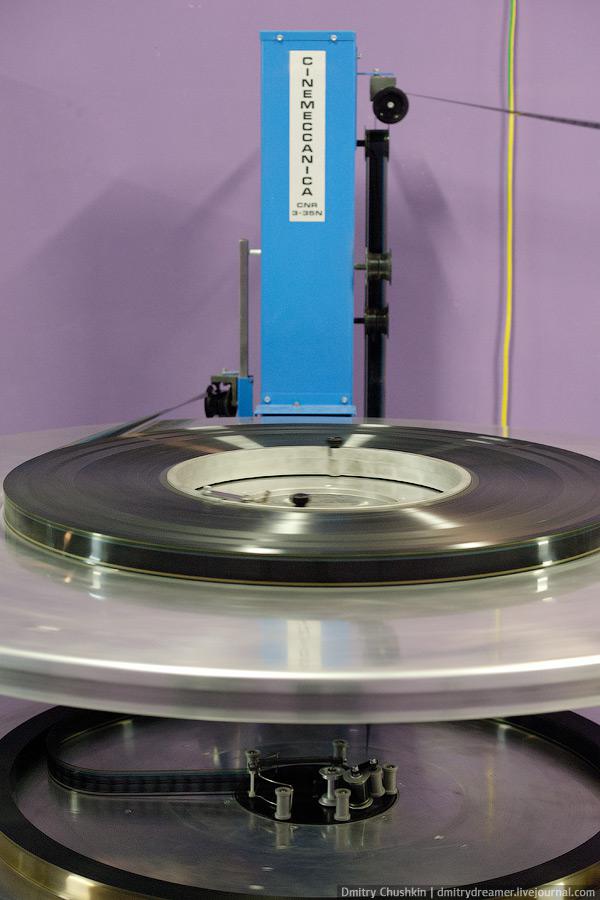
10. After the mega-coil is wound, it is mounted on a horizontal multi-tiered table. Next, the entire process is quite simple: with the lower film spool is in the projector, and after coming out of it and wound on the same mega-coil at the top tier.
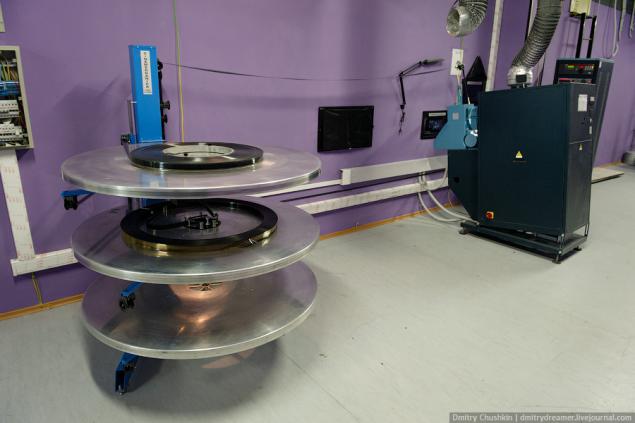
11. The system Rewind (platter) is designed for the transportation of the film when the film projector. In this film, after the demonstration does not require rewinding, since the beginning of the film will always be on the inside of the roll film. Platter is also used to prepare the film for a demonstration and assembly or disassembly of the film (bonding of parts or posting on the film).
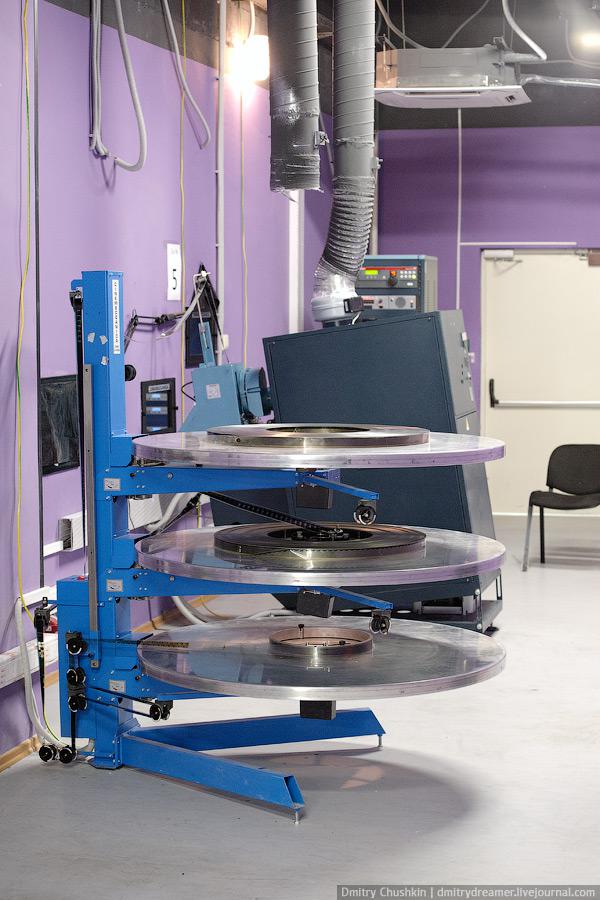
12. The mechanism of transfer film on the projector. Blue stripes on the edge of the film - is the soundtrack. But the sound we'll be back.

13. As long as the audience watching the film, the film is unwound and unwound all ...

14. And then unwound.
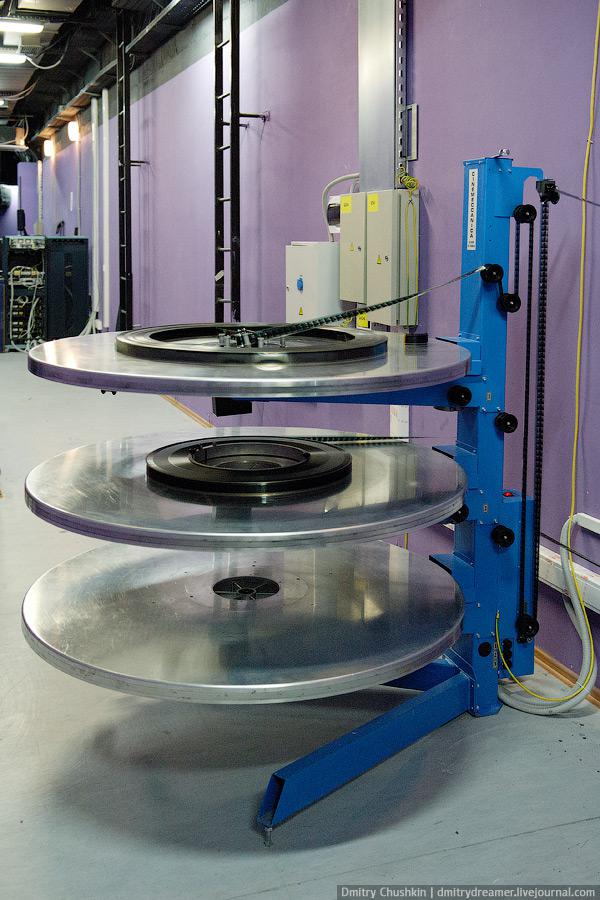
15. Mechanism lentoprotyazhki film at an angle.
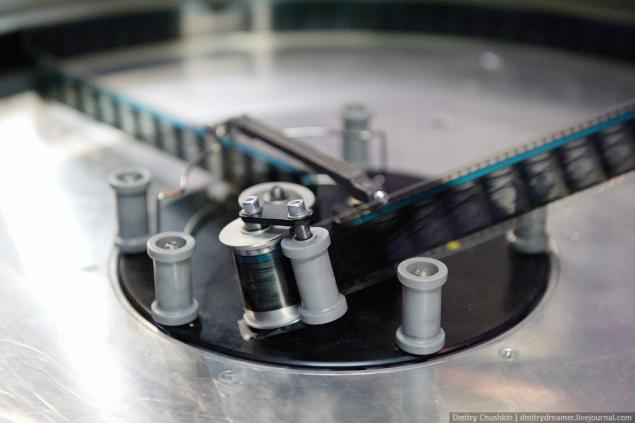
16. Machine for rewinding film reels with small to large and vice versa.
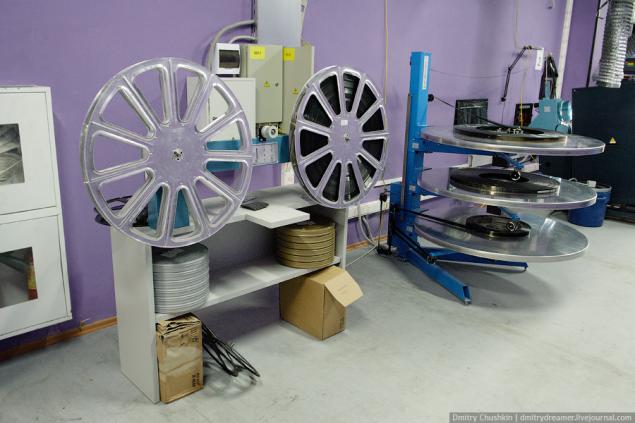
17.
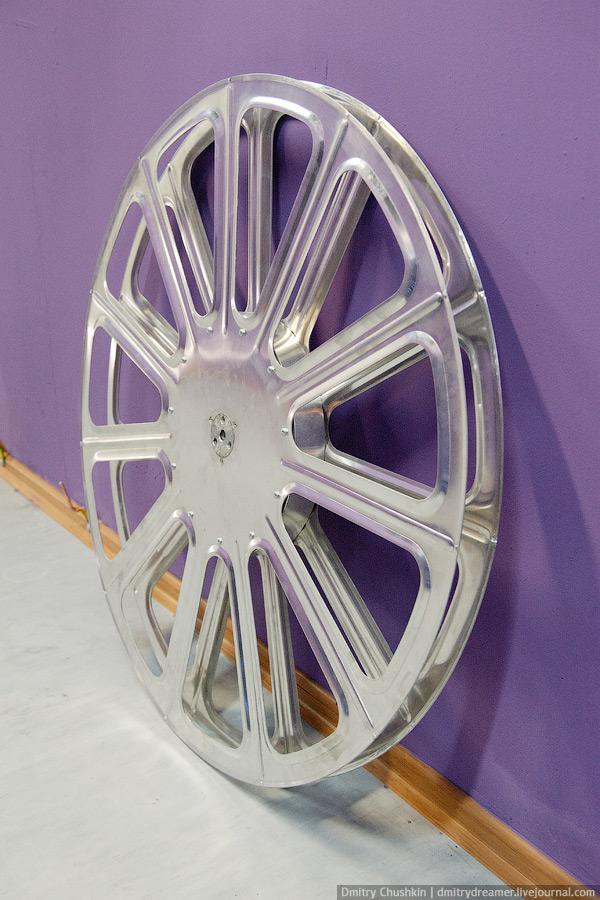
18. The film is charged to the projector and is ready to be shown. 1, 85 is the aspect ratio of 1: 1, 85. In this case, we have a widescreen movie with kashetirovannym frame.

19. The basis of the system with a widescreen movie kashetirovannym frame on the principle of reducing the height of a conventional (classical) shot on 35 mm film to such an extent in which the ratio of its sides corresponds to the desired aspect ratio of the screen. In the process of shooting the frame is assembled so that the most important objects are not closed (ie. E. Not kashetirovalis) for film projection.
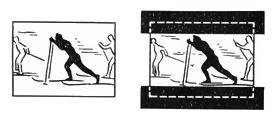
Kashetirovanie can be done by setting an appropriate framework in kinosёmochnom, and the film projector. In our time, do it when you print film copies. The main advantage of the system kashetirovannogo frame is that the processes of filming and film projection virtually unchanged. However kashetirovanie significantly reduces the effective area of the frame, which requires further increase it by projection on a screen using a short-optics. This somewhat worse sharpness and graininess increases. In general, if we compare the resolving power kashetirovannogo frame with other cinematic systems, then it is the lowest it. Nevertheless, the system kashetirovannogo frame gives satisfactory results in the aspect ratio of between 1: 1 and 66 - 1: 1, 85, and when using high kinoplёnok, projection optical systems and powerful light sources.
20. By the way, you know that the film does not move in front of the lens continuously? Each frame should be fixed to 1/24 second located in front of the lens. To create this effect using a Maltese mechanism. 21. All film projectors Italian company Cinemeccanica. The company was founded in 1920 in Milan and now holds the leading position in the production of equipment for cinemas. The projector consists of three main parts. The first of them - a block containing all the mechanics - the tape drive mechanism, the film channel, reading the sound head and the obturator, valve, and a turret.

The second part - the base of the projector contains all the electrical and machinery drives rolls of film. The electrical part is made with a minimum of electronic components. A simple circuit is easily repaired without special tools and unique parts. The third part - the lantern. In this model, a xenon lamp installed capacity of 4 kW.
Now a little closer look at the projector.
22. The tape drive mechanism of the projector.
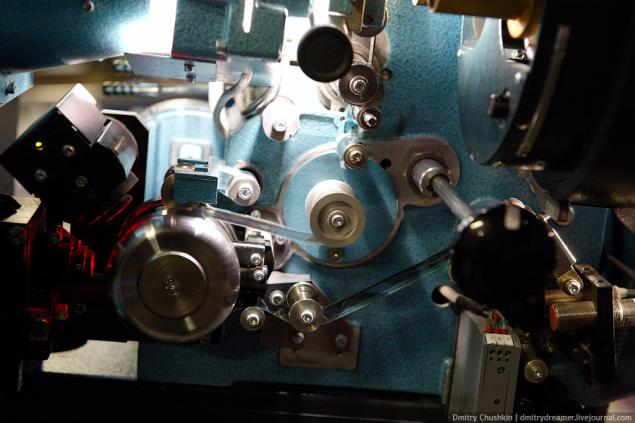
23. Optical unit with interchangeable lens turret.
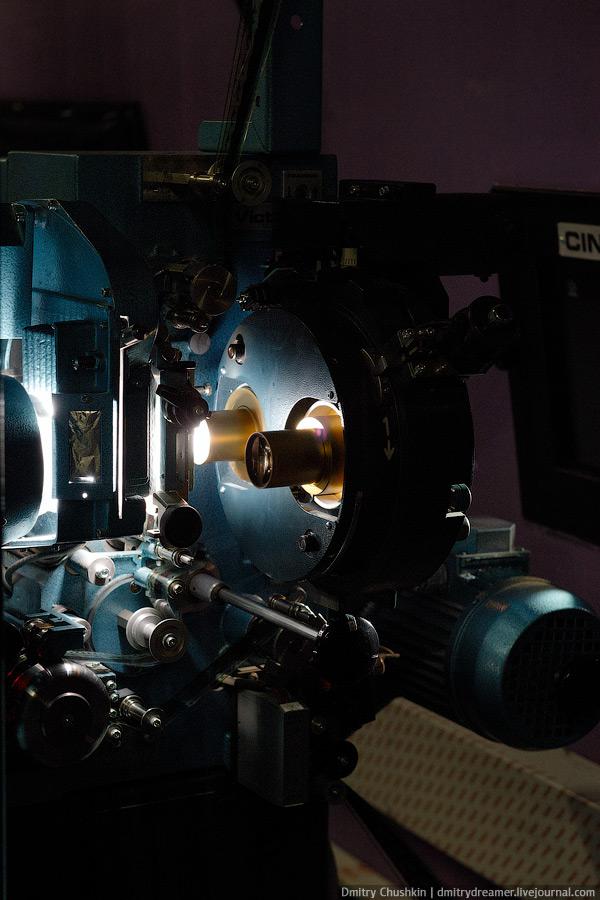
24. To change the lens, a different frame formats or screen, use the turret, the principle of which is the same as the drum revolver.
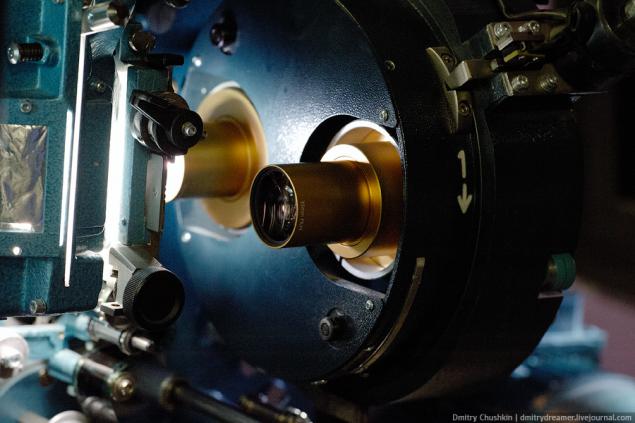
25. He was seen with a more powerful projector lamp is 7 kW and water-cooled.
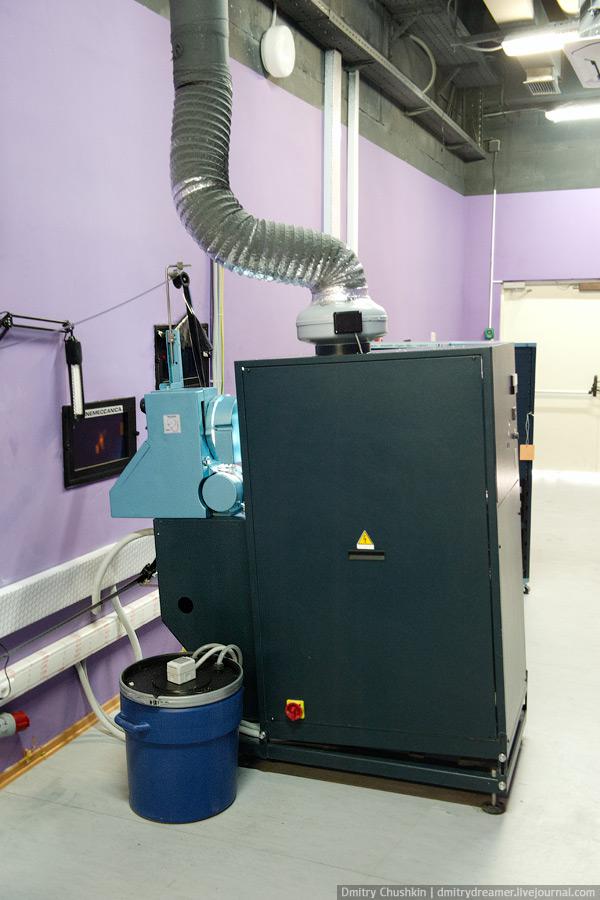
26.
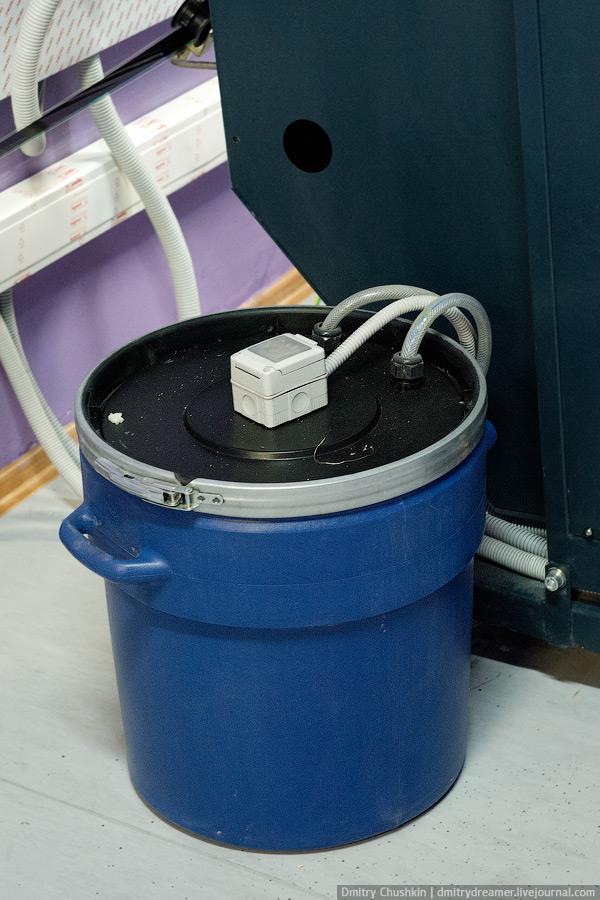
Well, with the film and the image we understand a little. And what about the sound? For processing and audio output, the projector is equipped with a sound processor, amplifier, CD player and discs if the soundtrack is recorded in a film, and is on a separate carrier.
Then I made for myself next discovery, or rather half-open. I firmly believed that the film is written only analog soundtrack, and modern digital formats such as Dolby, DTS, SDDS, are on an external drive.
27. DTS, this is the case. On the film is applied only to the synchronization mark. But Dolby and the SDDS is entirely on film!
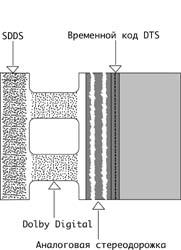
For particularly interested in the development of sound systems in the movies, I suggest prosledoavt link.
28. All of this desk is responsible for the soundtrack of the film in a cinema. Consider closely components.

Dolby CP650 cinema processor 29 to decode the sound format Dolby. The following CD player Marantz.

30. The processor for the management and control of the amplifier DSi-Series. It has 8 channels to monitor outputs cinema processor and / or amplifier input.
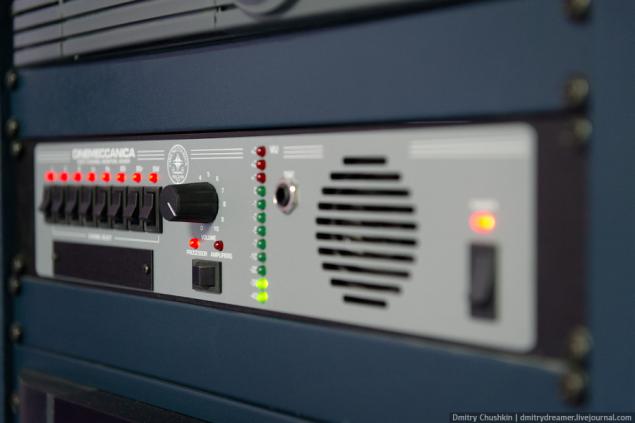
31. DSi amplifiers with integrated DSP-processor. As I understand it, one amplifier for each channel.
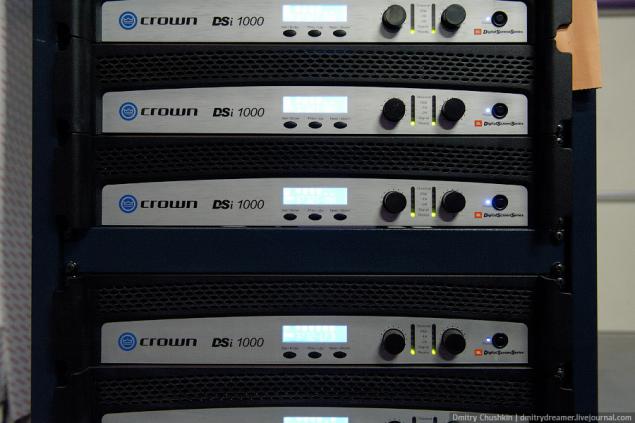
The second part of our story is about digital cinema. It's all a bit easier. Place film projectors projectors took the Belgian company Barco, founded in 1934. All projectors have a resolution of 2K (2048x1080). Even nail program, projectors IMAX - also digital 2K.
32. DLP projectors in this series consist of three DMD matrices having resolution 2048x1080. As it is written in its performance characteristics, the electronic part of the projector is ready to install a new generation of matrix with a resolution of 4K (4096x2160). So for the future is.
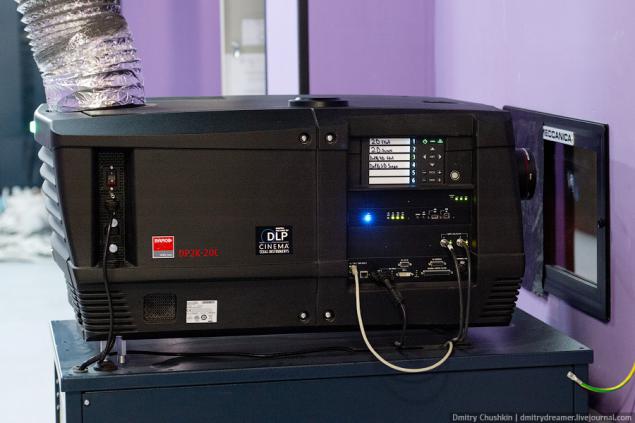
33. The control panel and various interfaces.
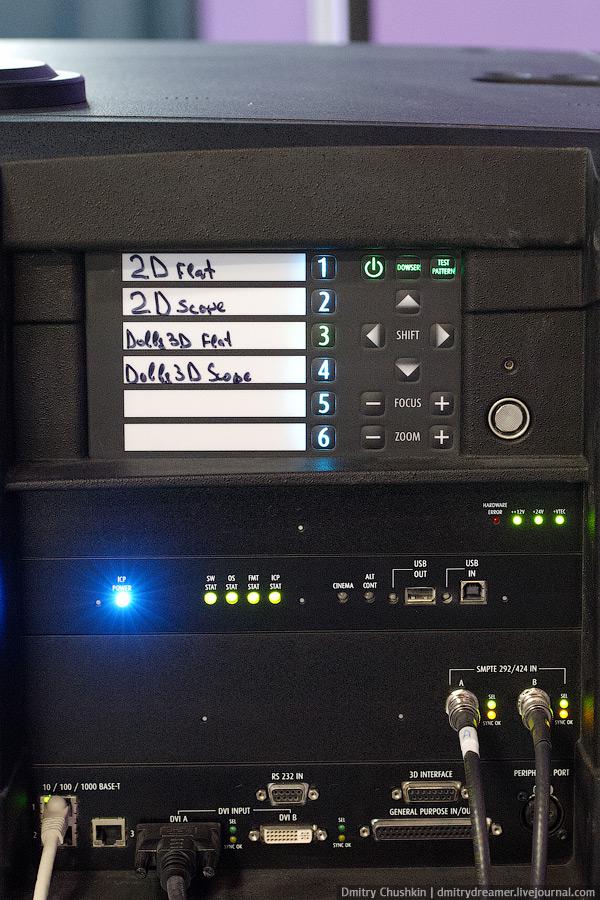
34. The player interface. Wieden playlist with advertising and the film itself.
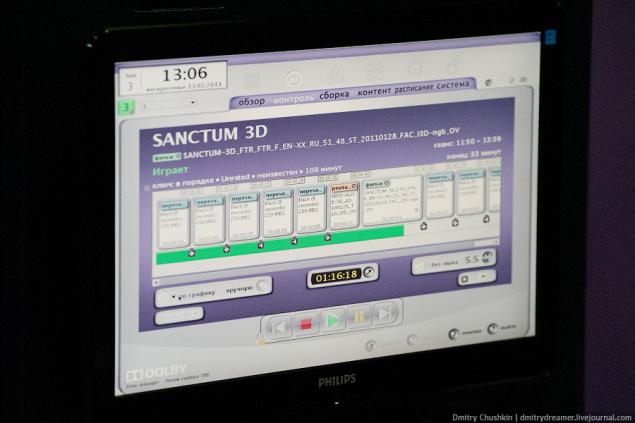
35. And there is a rather strong current!

36. Lens

37. Focus System lens.
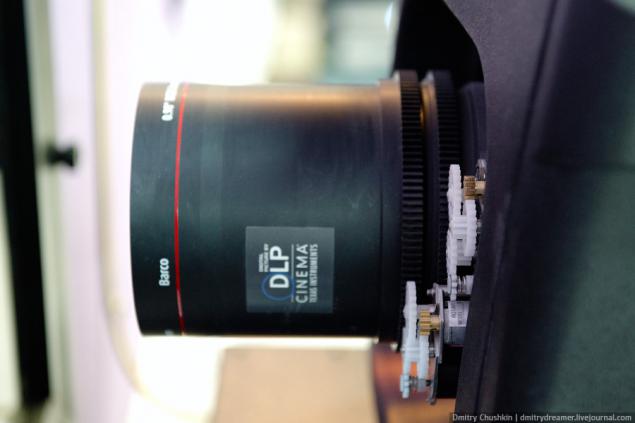
38. Another digital projector. To all the projectors is brought pipe to carry hot air from powerful lamps.

39. Lens.
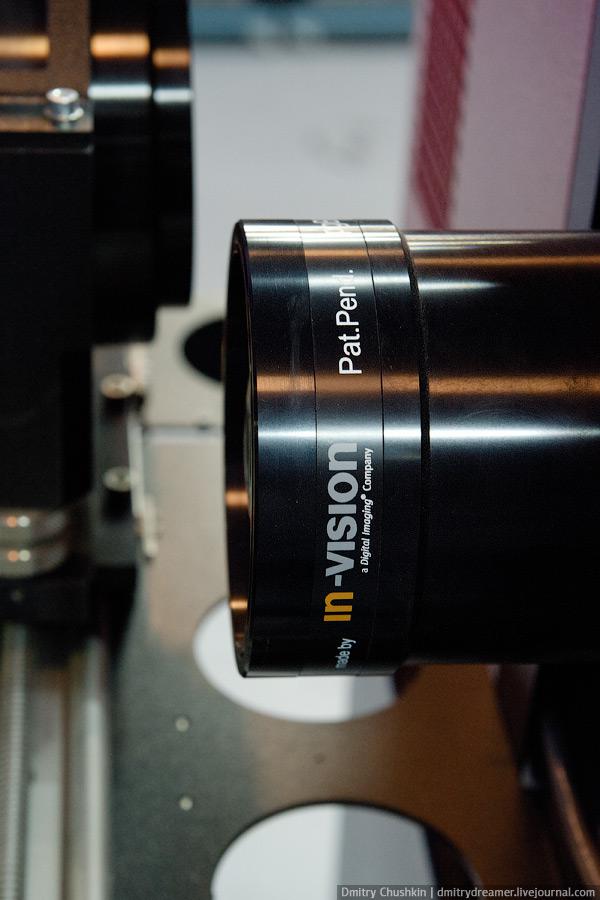
40. Some head to the main lens. He remembered the optical bench on laboratory studies on optics, the university
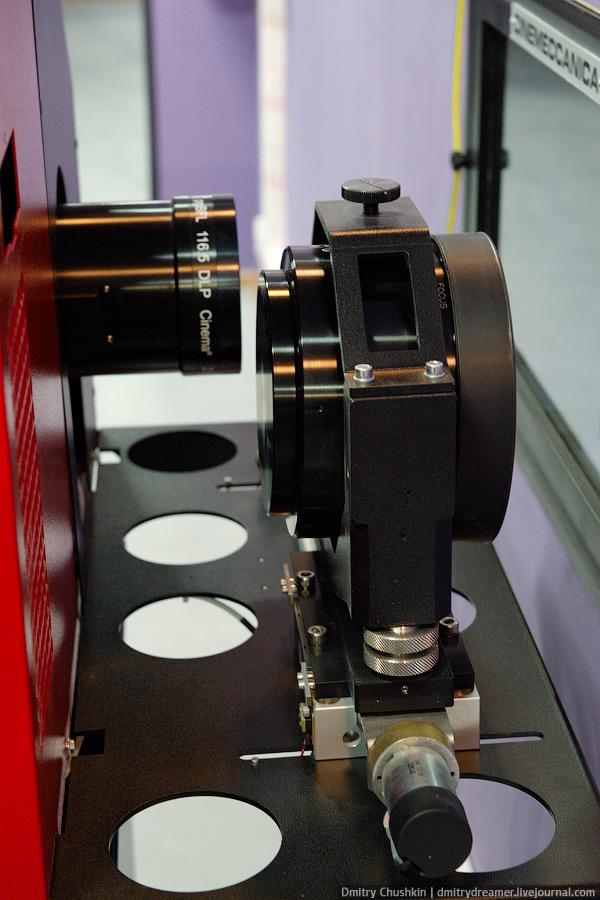
41. Tentacles Cthulhu?

42. Server DSS200.
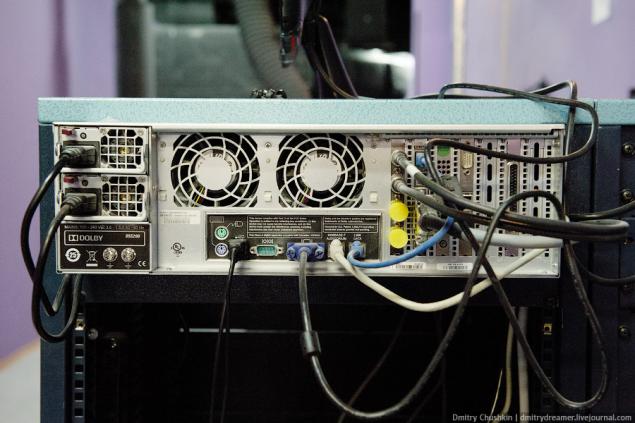
43. The server Dolby Screen Server DSS200 decrypts the movie data and decodes the image. It outputs the encrypted image data to the digital cinema projector, and audio data to a sound processor. For safety, when the content is decrypted, it is re-encrypted before being transmitted within secure hardware so pirates can not reach valuable movie data. It has a hard drive with the "hot-swap". The memory capacity of the internal RAID5 storage 1380 GB holds up to 10 feature films expectancy.
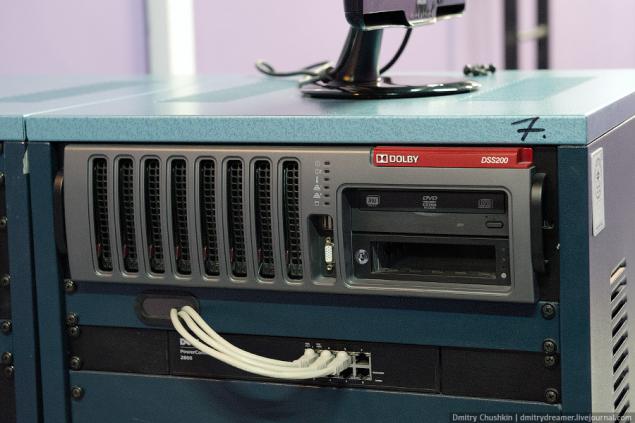
IMAX projectors strongly stand out among others. There is such a couple of cabinets on trucks, and the movie in 3D displays)
44. I could not resist and compete with them growth.

45. In general, the installation site IMAX'a was very dark, so that pictures a bit. And does not this system is fundamentally different from the usual: tezhe projectors tezhe "cabinets" control and signal processing. Perhaps the only thing that distinguishes this system, it's paired projectors, but set before objectives polarizers are strongly cooled by fans.

46. The player interface IMAX.

Many thanks to the leadership of the theater shooting and organization administrators Tatyana and Julia for the warm reception.
I'd add that the author was still flash panorama, but could not download them (
Source:
47 photos via
10th room was free all day, so you can not rush, and do some staged shots.

2.

3.

4. Taking a walk around the room, I made for myself a small opening. It turns out the screen surface is not continuous, and perforated over the entire area.

5. The answer was found pretty quickly. As soon as we went into the room behind the screen, we were greeted by the speakers are rather big subwoofer and center channel. To the sound from them reaches the viewer in its entirety and have made millions of holes in the screen.

6. Now go behind the scenes of leisurely. Classical room projectionist for each of the halls here. The unified system of corridors focused projectors working in all 10 rooms. Thanks to this designing the room, two people is enough to control all the settings.

In the long corridors between them peacefully coexist digital and film projectors. We begin our story with the film process.
7. Films on 35 mm film comes on a standard round bobbins. One film fits an average of six rolls.

8. At the beginning and end of each film there is leader tape - a blank portion of the film. Its purpose will be discussed below.

As the projectionist is controlled by this good? To do this, let's look at the pages of history. Previously, one room worked two projectors. This made it possible to show films without breaks between the parts. As soon as the part of one projector in sync with the projector includes another new part of the film. And so, on average, every 15-20 minutes. To projectionist just launched a new part of the film, at the end of each part is a black and white dots, squares (usually in the upper-right corner of the frame), which fueled the initial leader tape in the machine. When you see the final points of the leader tape projectionist manually start the engine and then the second lamp unit. By the way these points, and sometimes bezformennye squares and triangles can be seen in all the old movies. However manual synchronization was very ancient times. Less modern equipment already had automatic synchronization parts.
But modern technology does not cease to make life easier for the projectionist. Now it is not necessary every 15 minutes to put a new reel of film. Yes, and the projector is sufficient to have only one. That greatly simplifies maintenance.
9. Before showing the film, all the reels of film is wound into a coherent whole. Parts of the glue on the transparent leader tape. As I said, the mechanics, the length of the film in such a mega-coil about 5 km. The reader has the opportunity to find, so whether it is.

10. After the mega-coil is wound, it is mounted on a horizontal multi-tiered table. Next, the entire process is quite simple: with the lower film spool is in the projector, and after coming out of it and wound on the same mega-coil at the top tier.

11. The system Rewind (platter) is designed for the transportation of the film when the film projector. In this film, after the demonstration does not require rewinding, since the beginning of the film will always be on the inside of the roll film. Platter is also used to prepare the film for a demonstration and assembly or disassembly of the film (bonding of parts or posting on the film).

12. The mechanism of transfer film on the projector. Blue stripes on the edge of the film - is the soundtrack. But the sound we'll be back.

13. As long as the audience watching the film, the film is unwound and unwound all ...

14. And then unwound.

15. Mechanism lentoprotyazhki film at an angle.

16. Machine for rewinding film reels with small to large and vice versa.

17.

18. The film is charged to the projector and is ready to be shown. 1, 85 is the aspect ratio of 1: 1, 85. In this case, we have a widescreen movie with kashetirovannym frame.

19. The basis of the system with a widescreen movie kashetirovannym frame on the principle of reducing the height of a conventional (classical) shot on 35 mm film to such an extent in which the ratio of its sides corresponds to the desired aspect ratio of the screen. In the process of shooting the frame is assembled so that the most important objects are not closed (ie. E. Not kashetirovalis) for film projection.

Kashetirovanie can be done by setting an appropriate framework in kinosёmochnom, and the film projector. In our time, do it when you print film copies. The main advantage of the system kashetirovannogo frame is that the processes of filming and film projection virtually unchanged. However kashetirovanie significantly reduces the effective area of the frame, which requires further increase it by projection on a screen using a short-optics. This somewhat worse sharpness and graininess increases. In general, if we compare the resolving power kashetirovannogo frame with other cinematic systems, then it is the lowest it. Nevertheless, the system kashetirovannogo frame gives satisfactory results in the aspect ratio of between 1: 1 and 66 - 1: 1, 85, and when using high kinoplёnok, projection optical systems and powerful light sources.
20. By the way, you know that the film does not move in front of the lens continuously? Each frame should be fixed to 1/24 second located in front of the lens. To create this effect using a Maltese mechanism. 21. All film projectors Italian company Cinemeccanica. The company was founded in 1920 in Milan and now holds the leading position in the production of equipment for cinemas. The projector consists of three main parts. The first of them - a block containing all the mechanics - the tape drive mechanism, the film channel, reading the sound head and the obturator, valve, and a turret.

The second part - the base of the projector contains all the electrical and machinery drives rolls of film. The electrical part is made with a minimum of electronic components. A simple circuit is easily repaired without special tools and unique parts. The third part - the lantern. In this model, a xenon lamp installed capacity of 4 kW.
Now a little closer look at the projector.
22. The tape drive mechanism of the projector.

23. Optical unit with interchangeable lens turret.

24. To change the lens, a different frame formats or screen, use the turret, the principle of which is the same as the drum revolver.

25. He was seen with a more powerful projector lamp is 7 kW and water-cooled.

26.

Well, with the film and the image we understand a little. And what about the sound? For processing and audio output, the projector is equipped with a sound processor, amplifier, CD player and discs if the soundtrack is recorded in a film, and is on a separate carrier.
Then I made for myself next discovery, or rather half-open. I firmly believed that the film is written only analog soundtrack, and modern digital formats such as Dolby, DTS, SDDS, are on an external drive.
27. DTS, this is the case. On the film is applied only to the synchronization mark. But Dolby and the SDDS is entirely on film!

For particularly interested in the development of sound systems in the movies, I suggest prosledoavt link.
28. All of this desk is responsible for the soundtrack of the film in a cinema. Consider closely components.

Dolby CP650 cinema processor 29 to decode the sound format Dolby. The following CD player Marantz.

30. The processor for the management and control of the amplifier DSi-Series. It has 8 channels to monitor outputs cinema processor and / or amplifier input.

31. DSi amplifiers with integrated DSP-processor. As I understand it, one amplifier for each channel.

The second part of our story is about digital cinema. It's all a bit easier. Place film projectors projectors took the Belgian company Barco, founded in 1934. All projectors have a resolution of 2K (2048x1080). Even nail program, projectors IMAX - also digital 2K.
32. DLP projectors in this series consist of three DMD matrices having resolution 2048x1080. As it is written in its performance characteristics, the electronic part of the projector is ready to install a new generation of matrix with a resolution of 4K (4096x2160). So for the future is.

33. The control panel and various interfaces.

34. The player interface. Wieden playlist with advertising and the film itself.

35. And there is a rather strong current!

36. Lens

37. Focus System lens.

38. Another digital projector. To all the projectors is brought pipe to carry hot air from powerful lamps.

39. Lens.

40. Some head to the main lens. He remembered the optical bench on laboratory studies on optics, the university

41. Tentacles Cthulhu?

42. Server DSS200.

43. The server Dolby Screen Server DSS200 decrypts the movie data and decodes the image. It outputs the encrypted image data to the digital cinema projector, and audio data to a sound processor. For safety, when the content is decrypted, it is re-encrypted before being transmitted within secure hardware so pirates can not reach valuable movie data. It has a hard drive with the "hot-swap". The memory capacity of the internal RAID5 storage 1380 GB holds up to 10 feature films expectancy.

IMAX projectors strongly stand out among others. There is such a couple of cabinets on trucks, and the movie in 3D displays)
44. I could not resist and compete with them growth.

45. In general, the installation site IMAX'a was very dark, so that pictures a bit. And does not this system is fundamentally different from the usual: tezhe projectors tezhe "cabinets" control and signal processing. Perhaps the only thing that distinguishes this system, it's paired projectors, but set before objectives polarizers are strongly cooled by fans.

46. The player interface IMAX.

Many thanks to the leadership of the theater shooting and organization administrators Tatyana and Julia for the warm reception.
I'd add that the author was still flash panorama, but could not download them (
Source:








